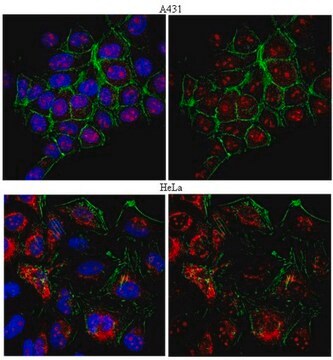ABE1462
Anti-phospho LSD1 (Ser 112) Antibody
from rabbit, purified by affinity chromatography
Synonym(s):
Lysine-specific histone demethylase 1A, Ser 112 phosphorylated, BRAF35-HDAC complex protein BHC110, Ser 112 phosphorylated, Flavin-containing amine oxidase domain-containing protein 2, Ser 112 phosphorylated
About This Item
Recommended Products
biological source
rabbit
Quality Level
antibody form
affinity isolated antibody
antibody product type
primary antibodies
clone
polyclonal
purified by
affinity chromatography
species reactivity
human, mouse
species reactivity (predicted by homology)
rat (based on 100% sequence homology), porcine (based on 100% sequence homology), zebrafish (based on 100% sequence homology), rhesus macaque (based on 100% sequence homology)
technique(s)
dot blot: suitable
western blot: suitable
NCBI accession no.
UniProt accession no.
shipped in
wet ice
target post-translational modification
phosphorylation (pSer112 )
Gene Information
human ... KDM1A(23028)
General description
Specificity
Immunogen
Application
Western Blotting Analysis: A representative lot detected phosphorylation induction of exogenously expressed human LSD1 upon PMA treatment of 24-hour starved HEK293T transfectants. Phosphorylated LSD1 was detected in the nuclear, but not cytosolic fraction and PKC inhibitor Go 6976 (Cat. No. 365250) co-treatment prevented PMA-induced LSD1 phosphorylation (Nam, H.J., et al. (2014). Mol. Cell 53:791-805).
Western Blotting Analysis: A representative lot detected a time-dependent LSD1 phosphorylation level in liver extracts from mice kept in a constantly dark (DD) cycle. Nuclear extracts from MEFs at different time points following circadian gene transcription induction by dexamethasone treatment likewise showed circadian-like oscillation of LSD1 phosphorylation level (Nam, H.J., et al. (2014). Mol. Cell 53:791-805).
Quality
Western Blotting Analysis: A 1:500 dilution of this antibody detected PMA-induced phosphorylation of exogenously expressed human LSD1 in 24-hour starved HEK293T transfectants. Lambda phosphatase treatment of the membrane prior to antibody probing completely abolished the target band detection.
Target description
Other Notes
Not finding the right product?
Try our Product Selector Tool.
Storage Class
12 - Non Combustible Liquids
wgk_germany
WGK 1
flash_point_f
Not applicable
flash_point_c
Not applicable
Certificates of Analysis (COA)
Search for Certificates of Analysis (COA) by entering the products Lot/Batch Number. Lot and Batch Numbers can be found on a product’s label following the words ‘Lot’ or ‘Batch’.
Already Own This Product?
Find documentation for the products that you have recently purchased in the Document Library.
Our team of scientists has experience in all areas of research including Life Science, Material Science, Chemical Synthesis, Chromatography, Analytical and many others.
Contact Technical Service








